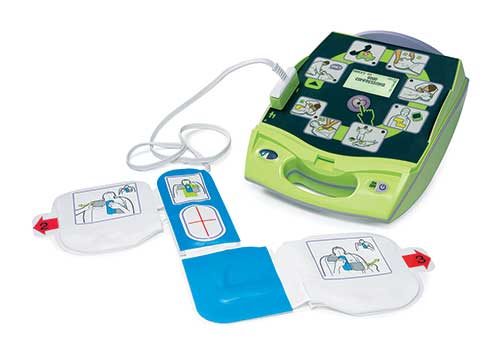AEDs in the workplace
How does using an AED increase a person’s chance of surviving sudden cardiac arrest?

Responding is Stephanie T. Cannata, senior manager, global public safety marketing, ZOLL Medical Corp., Chelmsford, MA.
An automated external defibrillator is a device used to treat victims of sudden cardiac arrest. SCA occurs when the heart suddenly and unexpectedly stops beating, interrupting blood flow and oxygen to the heart and brain. It’s a leading cause of death in the United States1 and can occur at any time – even in people believed to be healthy.
In fact, SCA affects more than 1,000 people each day in the United States – more than 40 people an hour. On average, only 10% of individuals who suffer cardiac arrest outside of the hospital survive,1 but the survival rate jumps to 38%2 when victims are treated with CPR and defibrillators. That’s why the American Heart Association has made early defibrillation an integral part of the basic life support chain of survival for treating patients in cardiac arrest.
How to help
The two key components to helping a victim of SCA are:
- CPR to restore blood flow to the brain and heart.
- An electrical shock from a defibrillator to stop the heart’s erratic beating and help enable it to restore its normal rhythm.
If you witness someone experiencing SCA, call 911 and immediately initiate CPR. Have a bystander quickly bring the closest AED. With average emergency medical service response times at seven to 12 minutes,3 every minute is critical. Starting CPR right away can help save the victim’s life.
When the AED is turned on, it will prompt the rescuer with instructions. Monitoring pads placed on the patient’s bare chest enable the device to measure the patient’s heart rhythm and determine if an electrical shock is needed. A shock will not restart the heart – it simply stops the erratic electrical activity and helps the heart’s natural pacemakers restore its normal rhythm.
Not every victim will need a defibrillating shock, and not all heart rhythms are “shockable,” but high-quality CPR can potentially convert a non-shockable rhythm into one that is shockable. Even if this isn’t possible, high-quality CPR will provide the heart with desperately needed oxygenated blood until EMS arrives.
AEDs can mean the difference between life and death
Public access to AEDs is critical to help save lives. Most AEDs are simple enough for anyone to use in an emergency. They should be located in public places where people gather, highly visible and easily accessible. Time is of the essence when helping a victim of SCA, so AEDs should never be locked away or hidden from view.
Do you know where the AEDs are in your workplace? Have you learned CPR? How can you play a role in ensuring more AEDs are readily available?
References
- Go A.S., et al. Circulation. Jan. 21, 2014; Vol. 129(3): e28-e292.
- Weisfeldt M.L., et al. Journal of the American College of Cardiology. 2010; Vol. 55(16): 1713-1720.
- Mell, H.K. JAMA Surgery. October 2017; Vol. 152(10): 983-984.
Post a comment to this article
Safety+Health welcomes comments that promote respectful dialogue. Please stay on topic. Comments that contain personal attacks, profanity or abusive language – or those aggressively promoting products or services – will be removed. We reserve the right to determine which comments violate our comment policy. (Anonymous comments are welcome; merely skip the “name” field in the comment box. An email address is required but will not be included with your comment.)

